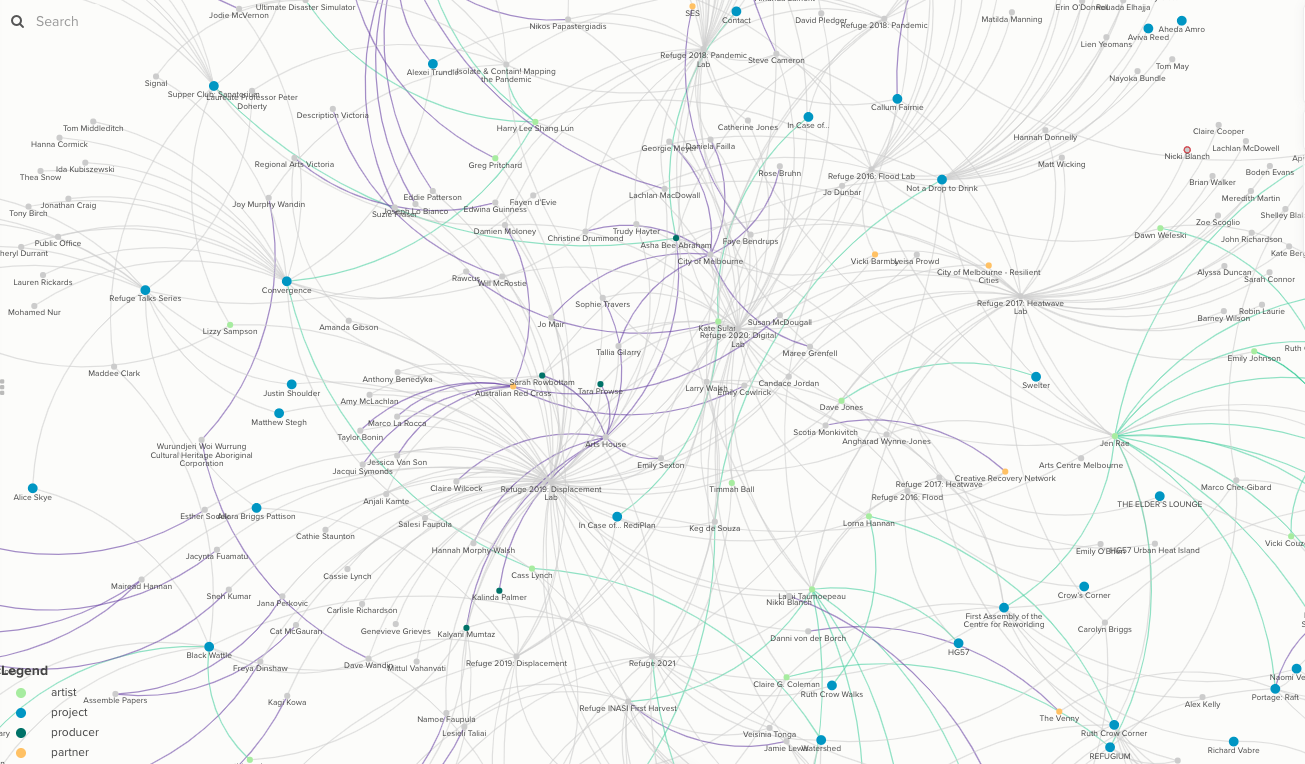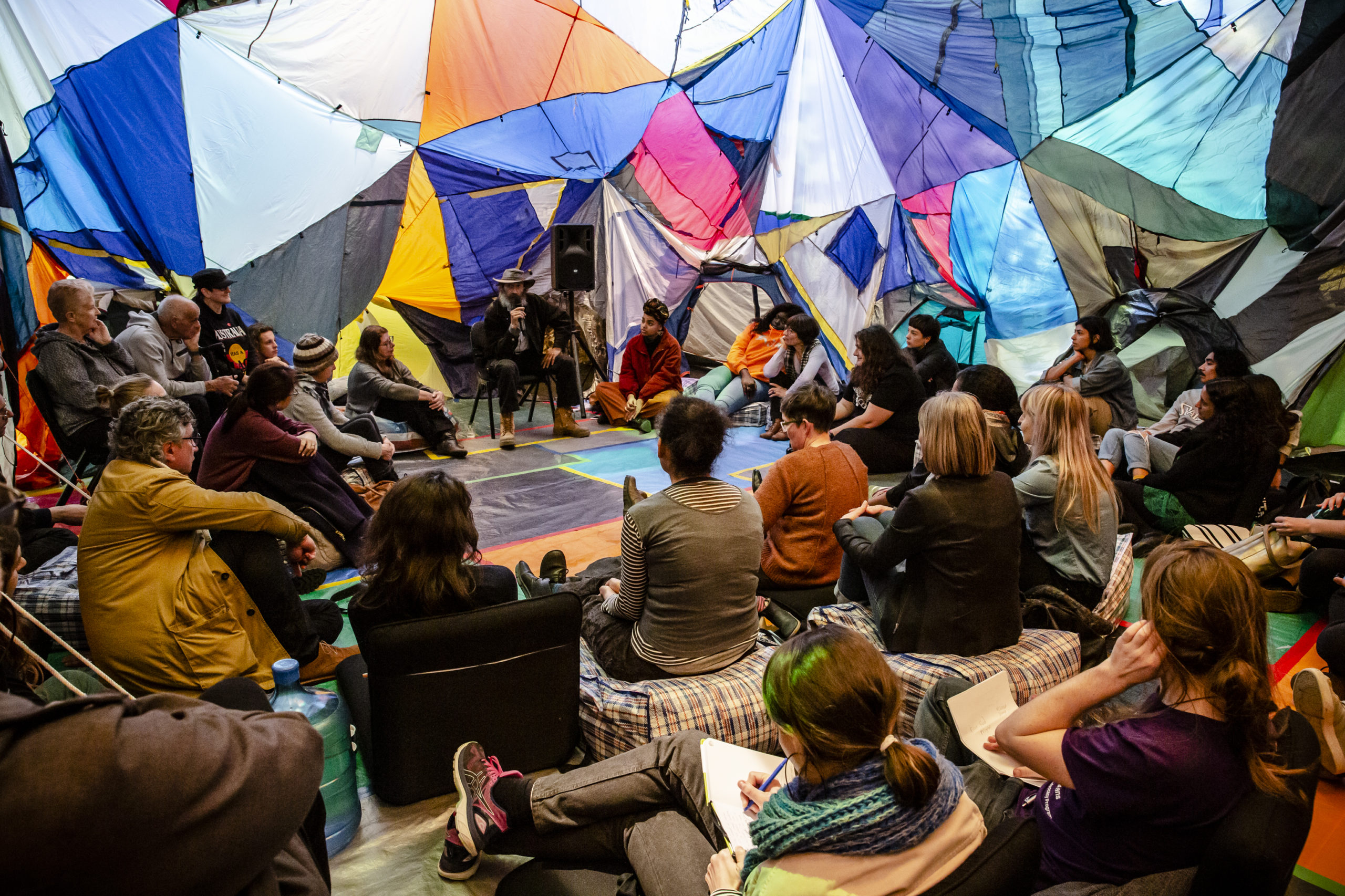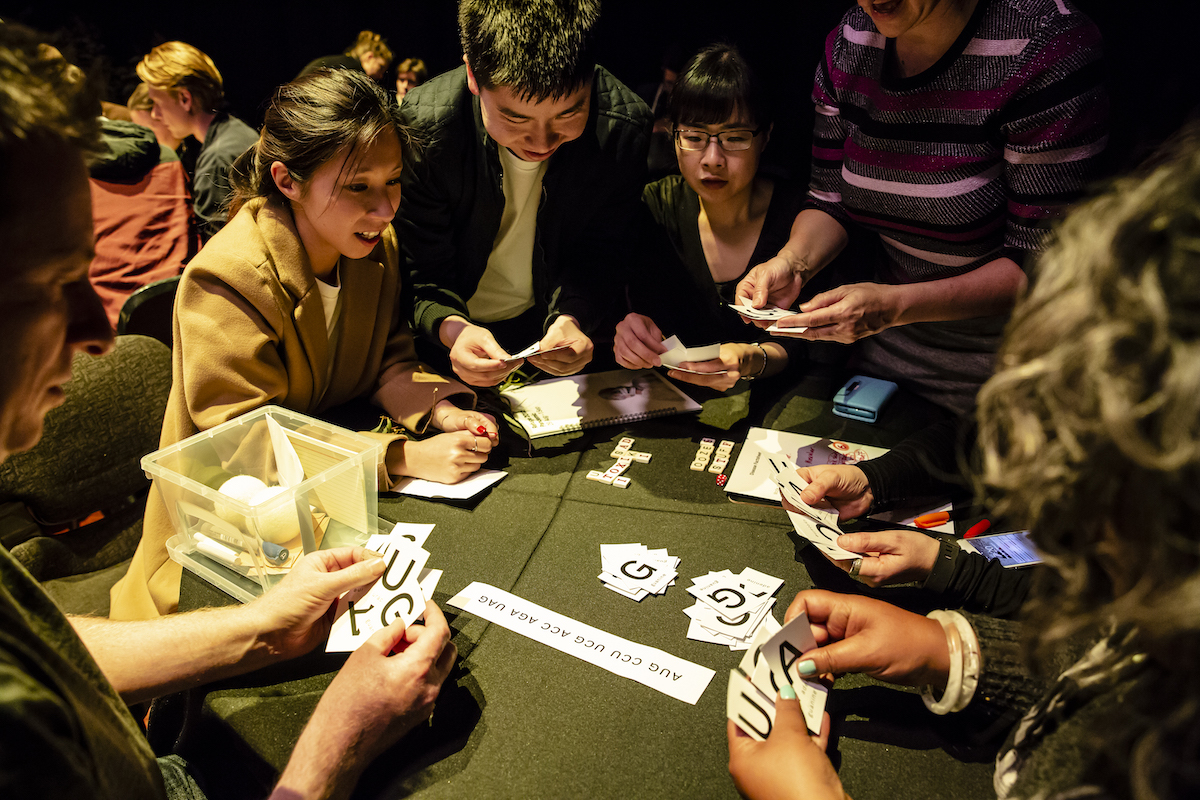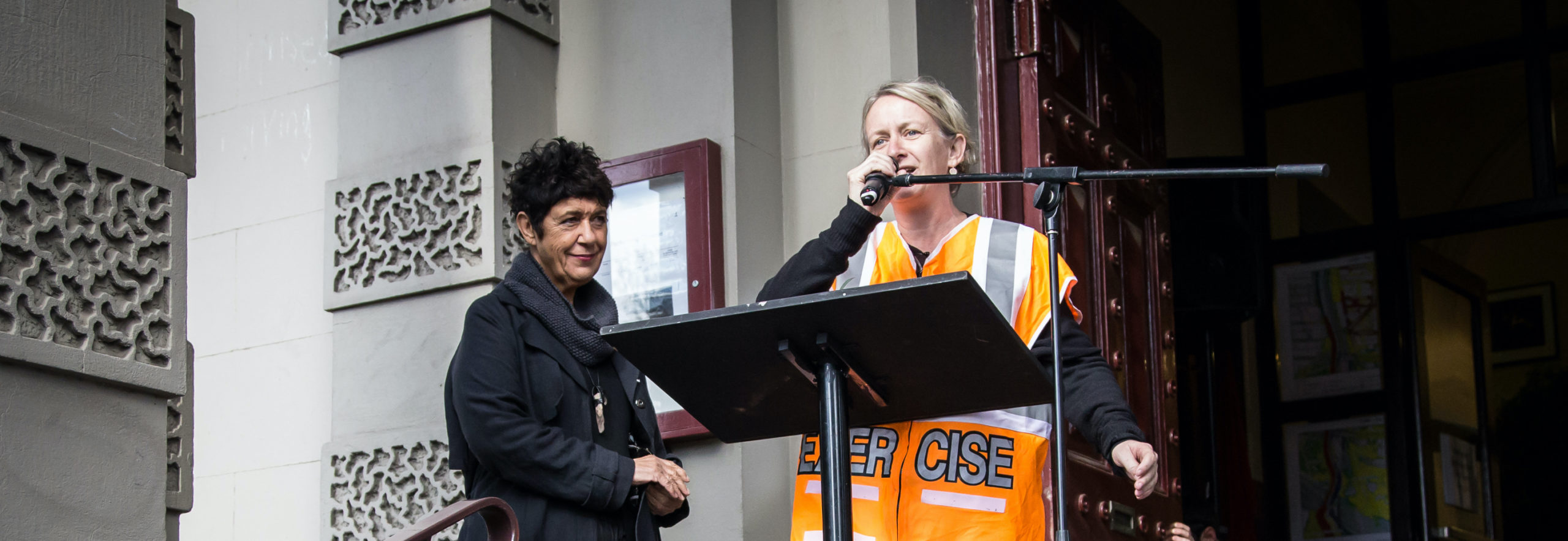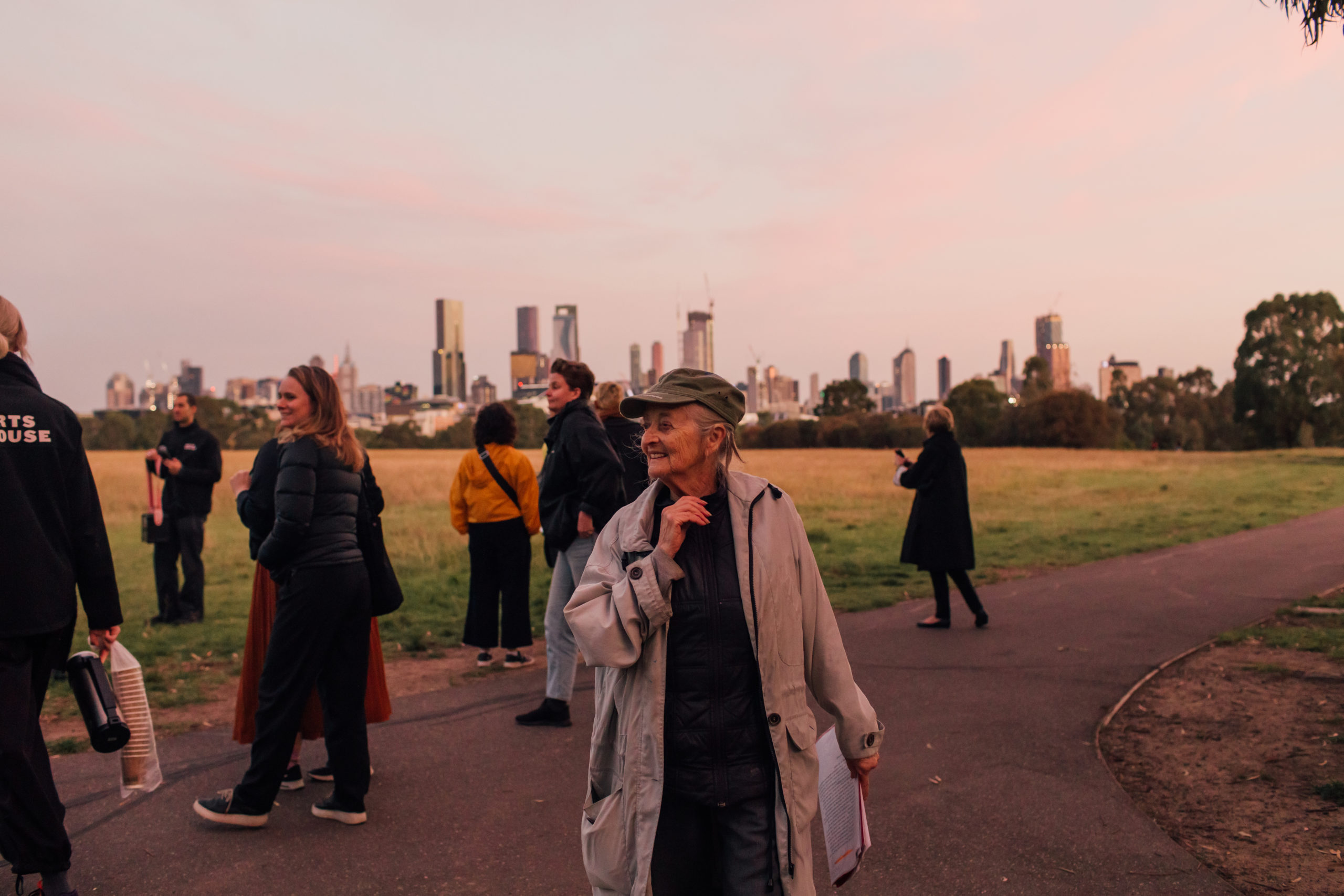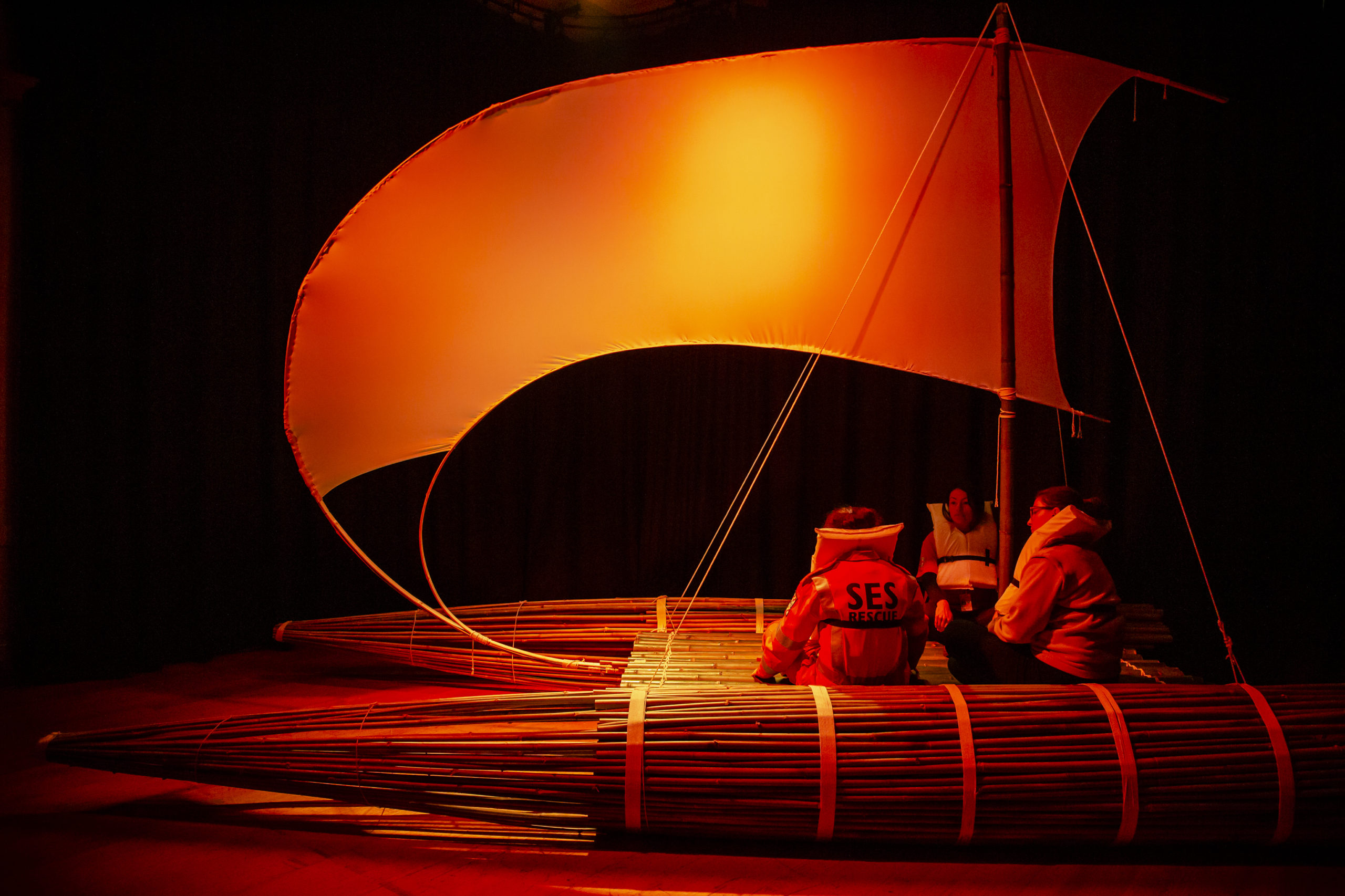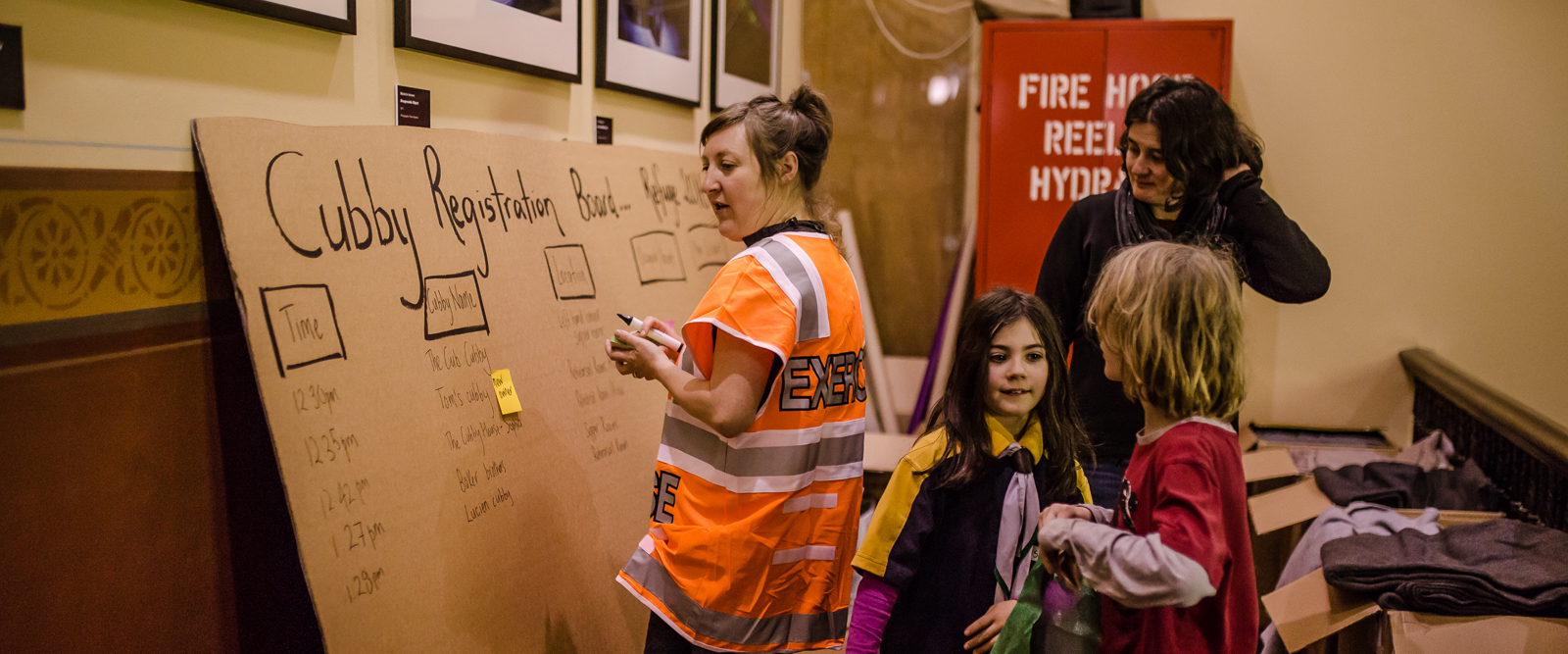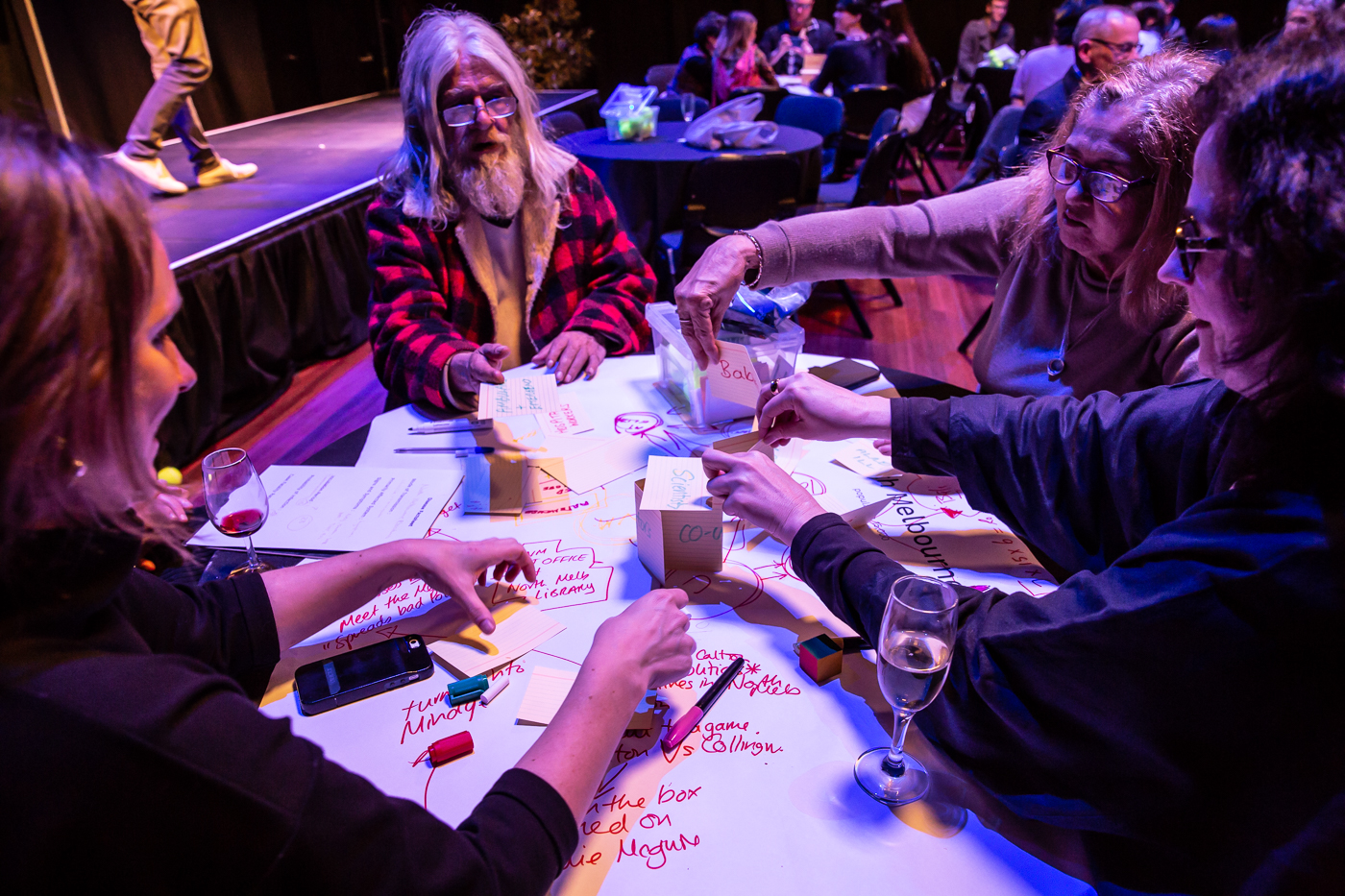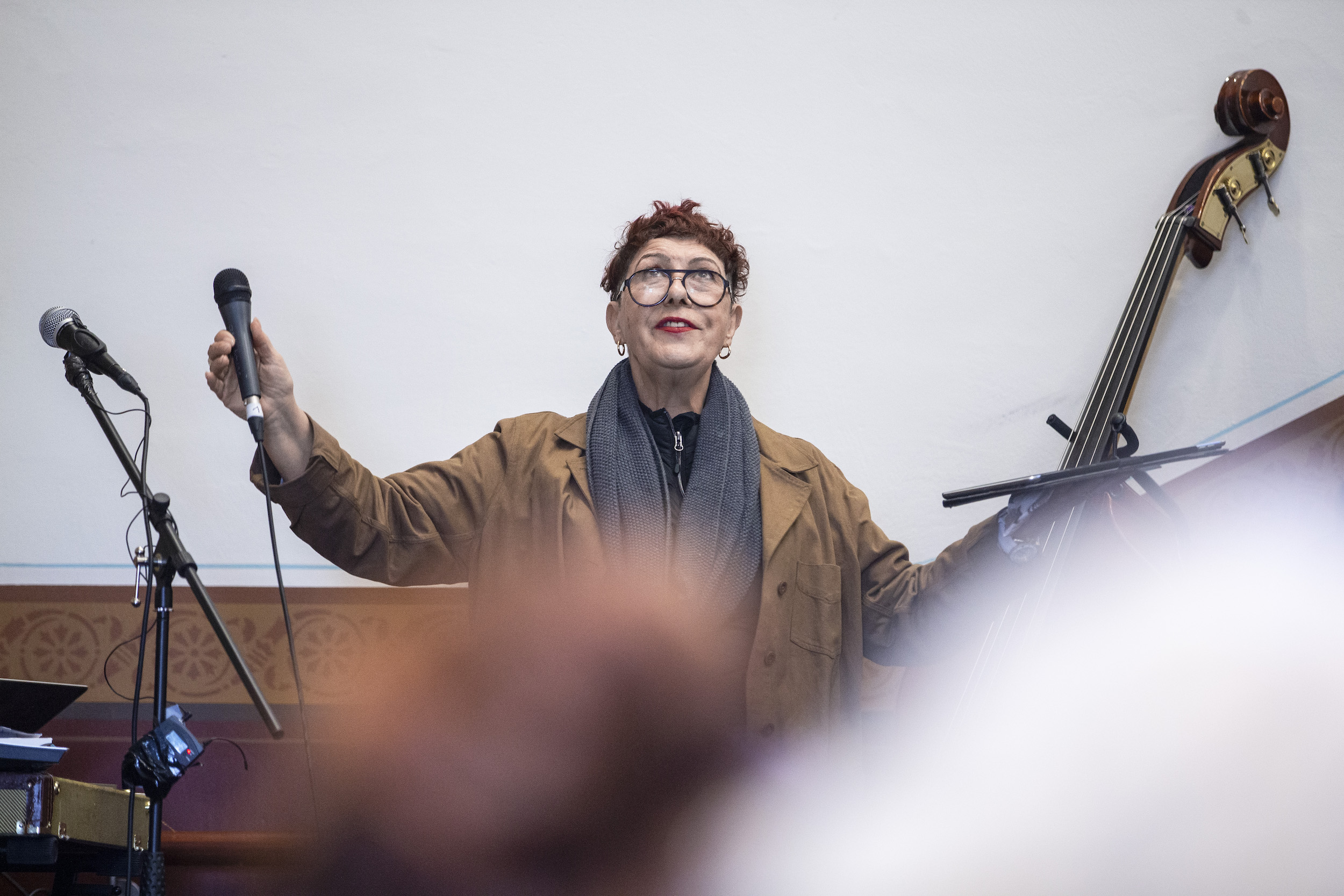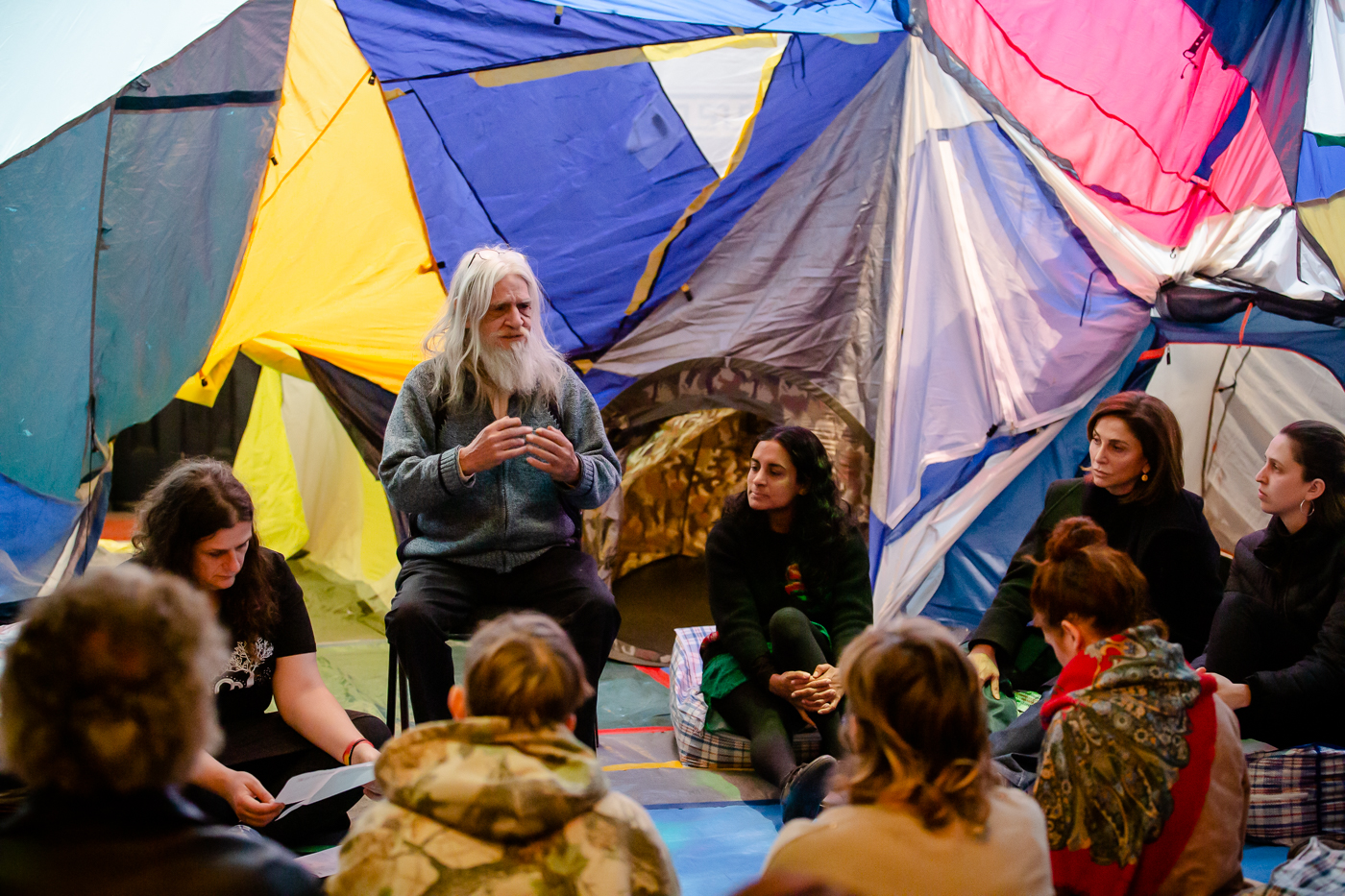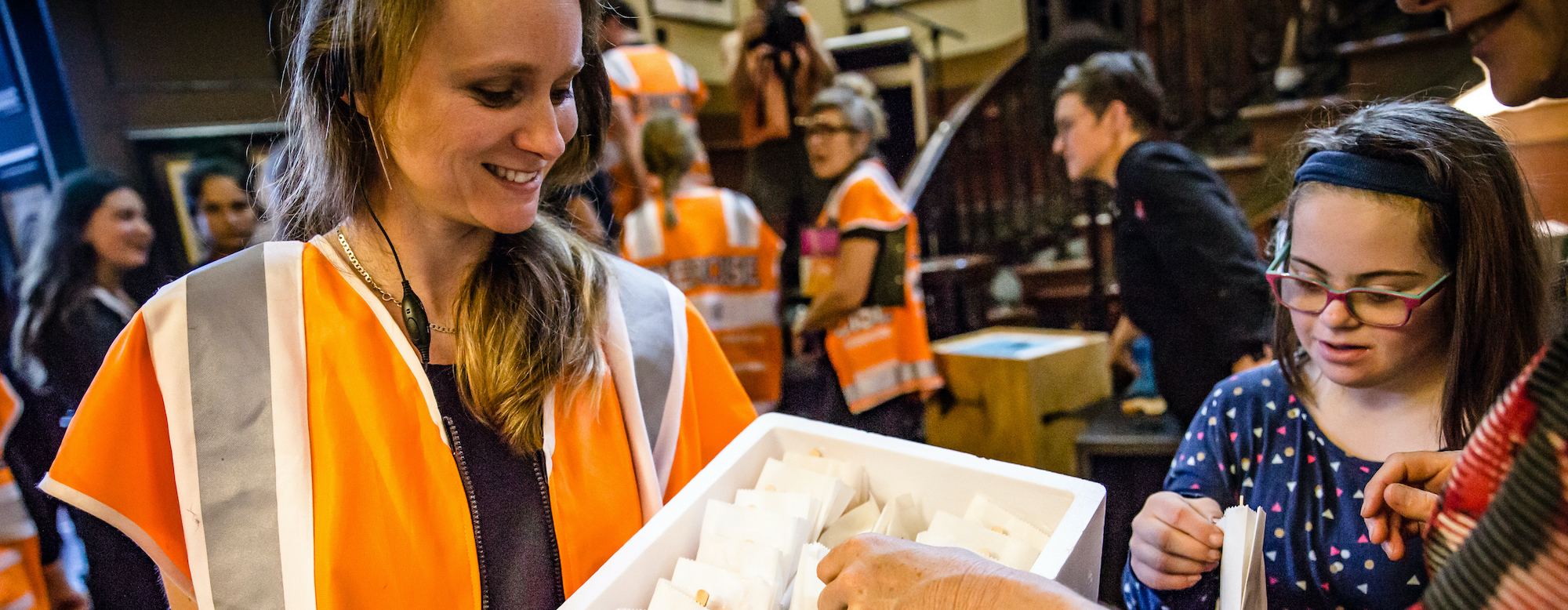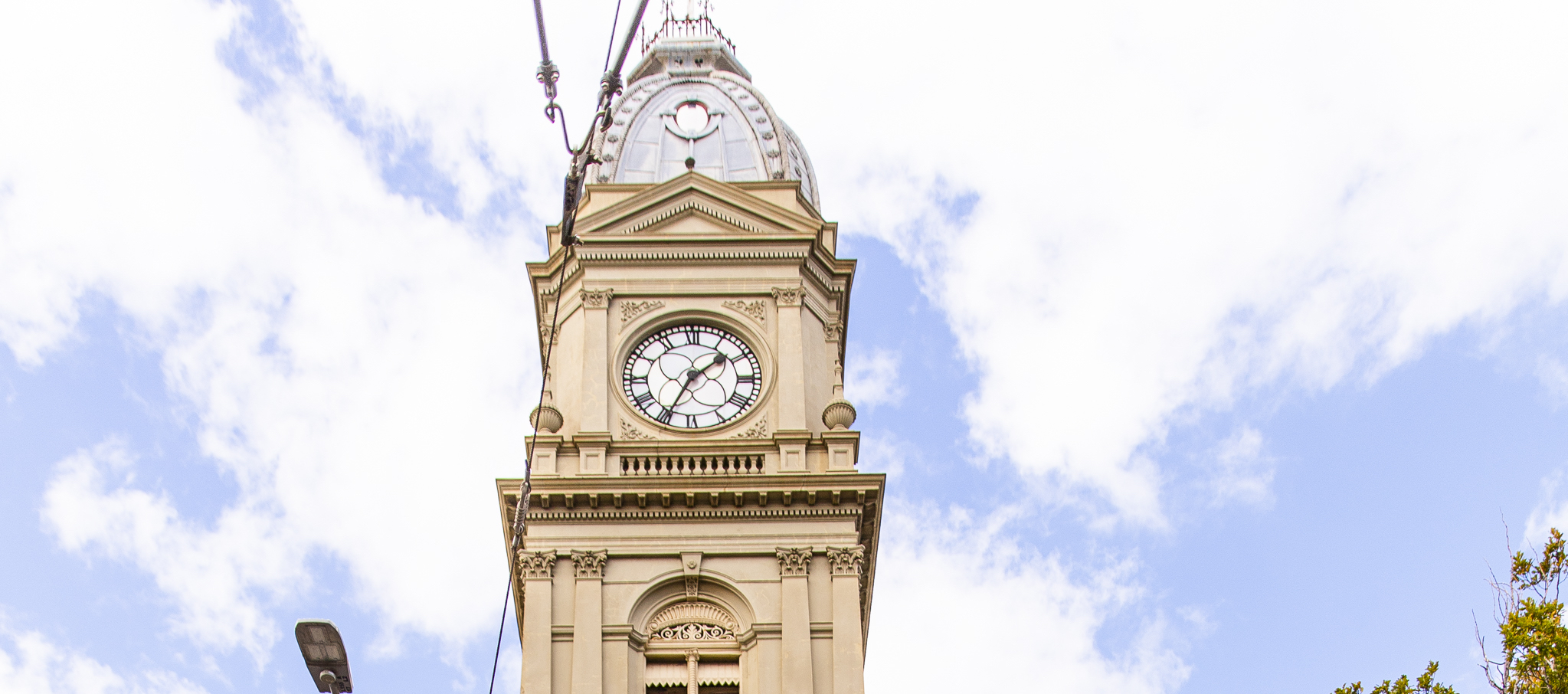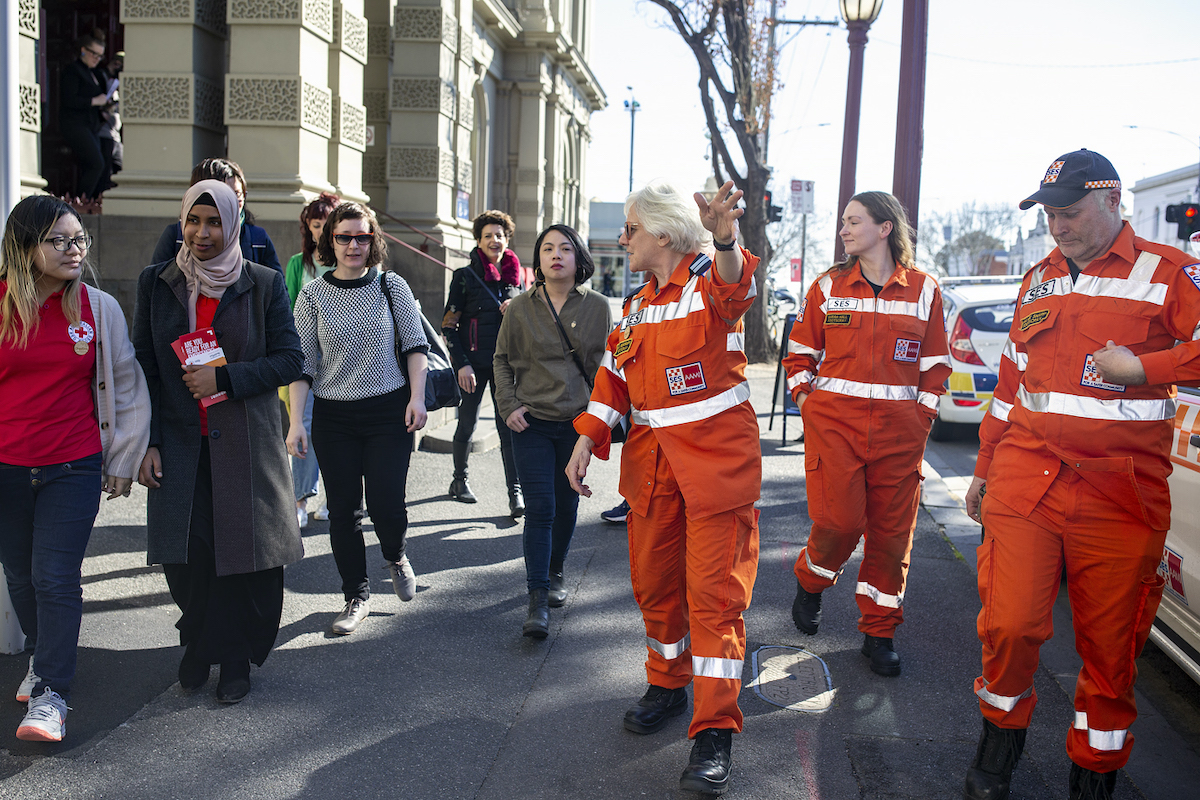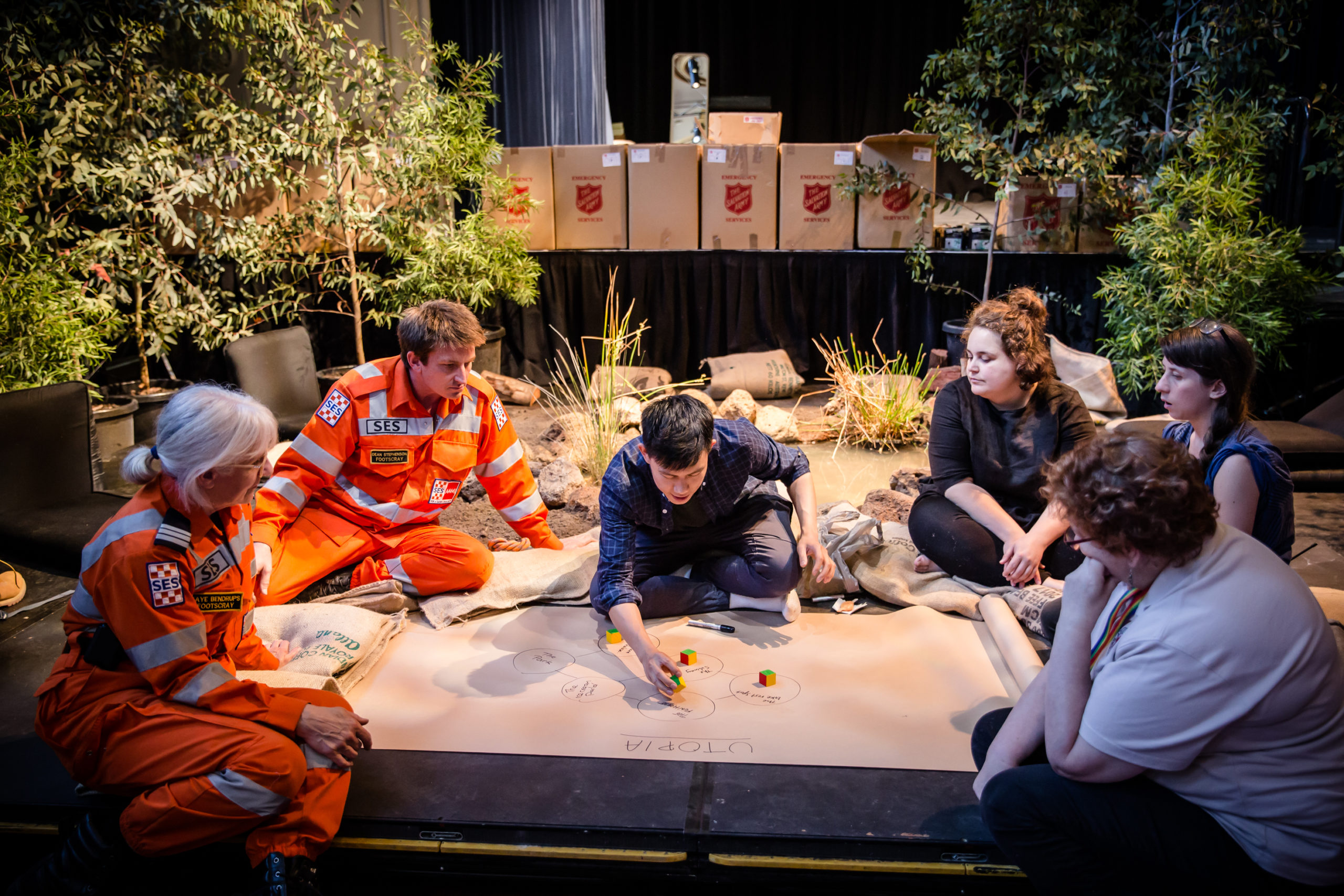A Fresco in a Cathedral…
David Pledger
This piece is from the collection, In The Time of Refuge.
Artistic
As an artistic endeavour, Refuge has multiple points of entry. It draws together artists from various disciplines, many cultures and histories. Its strength lies in its lack of clarity; it’s clearly not clear what it is. Each annual program is difficult to read, and some individual years’ programming is more difficult to read than others. The curatorial ingenuity lies in allowing the artists to find the program every year whilst creating an architecture highly inclusive of non-arts stakeholders from community, emergency services and eventually the public. This kind of programming is extremely difficult to ‘get away with’, perhaps only possible in the confines of a city council department where Arts House sits as a program of the City of Melbourne. It also represents a communications challenge. Sure, there are pressure points in the programming to pique cultural interest but the overall ‘sell’ in the initial years is the simulation of an emergency relief centre in a near-future scenario taking place at an arts centre dedicated to experimental, contemporary performance. It requires the valorisation of ambiguity in the face of confusion leading to forensic inquiry. And while none of these elements are unique on their own, once configured together in the one space, they become so.
From the outset, there was an intention to curate artists with an artistic empathy for the program’s dramaturgical trajectory and the stamina to sustain long-term inquiry. There is an informal group of core program artists; there are core artists for each year’s program and there are artists whose tasks are not creation but collaboration and mentorship. These groups overlap as do their skillsets. Whether they are presenting a work in a given year, many of the artists from the three groups will participate in the LAB each year. In some years, an artist has taken up a residency and not made or presented a work. The refusal to foreground a ‘result focus’ in the dramaturgy is distinctive, even more so when the dramaturgy must be explained to non-arts stakeholders who tend to be result-focused. Also, because of the need to collaborate outside the arts, artists were chosen because of the skill they had in collaborating with other fields of expertise. We might call these artists inter-disciplinary; they might call themselves anti-disciplinary; they might not ascribe any descriptor whatsoever. So, in support, we refuse any categorisation; the ascription of categories to artists often confines one aspect of their practice and amplifies it above others. We note that such ascriptions are often made by academics, commentators and bureaucrats and rarely by artists unless they are dealing with academics, commentators and bureaucrats. We point to the descriptor ‘creative arts’ and ask what arts are not creative?
One of the key features of Refuge’s dramaturgy is the artists’ use of ‘participation’ as a mode for engaging publics in the annual programs. Participation may appeal more to audiences than artists. This is not to suggest any resistance by artists to directly engage with audience but a broader understanding of the creeping disavowal of participation in governmental democracy and its impact on the arts. Citizens have a participatory reflex that is now thwarted in the political space and needs to be satisfied elsewhere. In Western democracies, artists have become go-to people for sating this reflex. It’s worth noting that the ‘participatory’ in artistic practice has risen concomitantly with the reduction of public services. As government divests itself of the responsibility of engaging citizens, ‘participation’ gets referred to the arts like a sick patient. In Refuge, the mode of ‘participation’ is simultaneously contested, implied, hidden, exposed and dis/regarded.
It’s worth acknowledging the influential view of art historian Claire Bishop who argues that social participation in the arts is merely participation in the task of being individually responsible for what, in the past, was the collective concern of the state (2012, 34). So, the artist becomes co-opted and thus complicit in the ‘social contract’ of neo-liberalism. The success of their art is measured by their ability to convince the participants in their project to accept its accumulating unfairness and inequality. This paradox underlies much contemporary arts practice which is a consequence of cultural policy in many Western democracies. An exemplar of this approach is UK New Labour’s instrumentalist policy of the 2000s that put the arts at the service of government as an agent of social regeneration, the effect of which was to place artists in situations for which they had little training or expertise and, conversely, for that expertise to be lost from the public sector.
However, the instrumentalization of the arts and artists is not a corollary of projects like Refuge. It is down to a matter of methodology. Just as artists need to be involved in all forms of disaster planning and communications so, too, must representatives from emergency services organise “residencies” with artists. The flow of thinking, feeling and making change needs to be spherical (Papastergiadis 2017). This is now a matter of urgency created by our precarious proximity to the tipping point of humanity’s efforts to avoid the cascade effects of global warming that threaten to plunge the world into a rolling disaster zone. In the context of art, the question now is whether this urgency re-frames the discourse around instrumentalization and social participation. More clearly, does the urgency of the artistic mission in Refuge dissolve, absolve, de-materialise the arguments of instrumentalization or does the intent and methodology combined with the urgency of the material transcend the discourse above social participation, above such arguments altogether? Does the immediacy of the catastrophic effects of climate change crystallise the purpose of art as method as opposed to art as a mechanism of government policy? Refuge forcefully asks this question.
Curatorial
The program’s curatorial approach is shared, distributed and avowedly undefined. Over the program’s course, artistic directorship of Arts House passed from Angharad Wynne-Jones to Josh Wright (acting) to Emily Sexton; senior management passed from Catherine Jones to Sophie Travers and key creative producing roles from Tara Prowse to Sarah Rowbottam. All of whom have respectively signed off on the Refuge program. Incumbent Artistic Director, Emily Sexton describes her approach as not wanting to direct, shape or curate but to hold for a time. There are many reasons for this. It is an approach that is faithful to the original curatorial concept, less of a program of arts projects than an artistic inquiry into the intersection of climate change, emergency services and community. Then there is the imperative that the program is ‘artist-led’; the desire to share with and cede responsibility to artists in project and some programming contexts. Third, the conviction that the more open the program the more porous it will be to diverse interests and knowledges, artistic, sectoral and cultural, and in the latter case, specifically First Nations.
Governing these factors is the disruption Refuge poses to the organisation of time in the conventional settings of artistic and cultural production in Australia. The received temporality of a season of shows, a subscription package, a one-off event is dismantled by a program delivered over 5 years rather than an ‘artistic product’ to be consumed either side of drinks at interval. It is a sign to artists and arts workers that their practice needs to shift, and a signal to those participants outside the arts of the expectation that their commitment must be reconfigured for the adventure to succeed.
In this context, it is worth unpacking a key part of the program’s dramaturgy which is both (highly) porous and (rigorously) protected (held). Each annual cycle usually comprises a laboratory (LAB), artist residencies, a program of public events including commissioned artworks, collaborations, forums, provocations and, in the first 2 years, an emergency exercise simulation. The key dramaturgical strategy here is LAB.
In the arts, a laboratory is standard operating procedure. Most artists and arts workers understand the concept of the laboratory before engaging in its methodology. An arts lab is open-ended, focussed on process, a journey of curiosity. Transposing this mechanism into a cross-disciplinary, cross-sectoral landscape is not an easy task. It can polarise positions and reinforce difference, meaning it can have the opposite effect of its intention. Considerable skill is required to ensure this does not happen.
In 2016, Arts House assembled a laboratory of artists, cultural operators and experts and stakeholders including representatives from urban planning, climate science, local community, Indigenous Elders and key members of the emergency services sector including Faye Bendrups, Controller of Footscray’s State Emergency Services Unit, Steve Cameron, Manager of Community and Volunteer Development for Emergency Management Victoria (EMV), Christine Drummond, City of Melbourne’s Emergency Management Services Co-ordinator, and later, Damien Moloney of the Australian Red Cross. The LAB became a field in which many seeds were sown – ideas for artworks, thematic navigation, concept development, curatorial framing, cross-sectoral collaboration, ‘expert’ exchange, knowledge transfer. It is where the foundations of the ensuing program were laid.
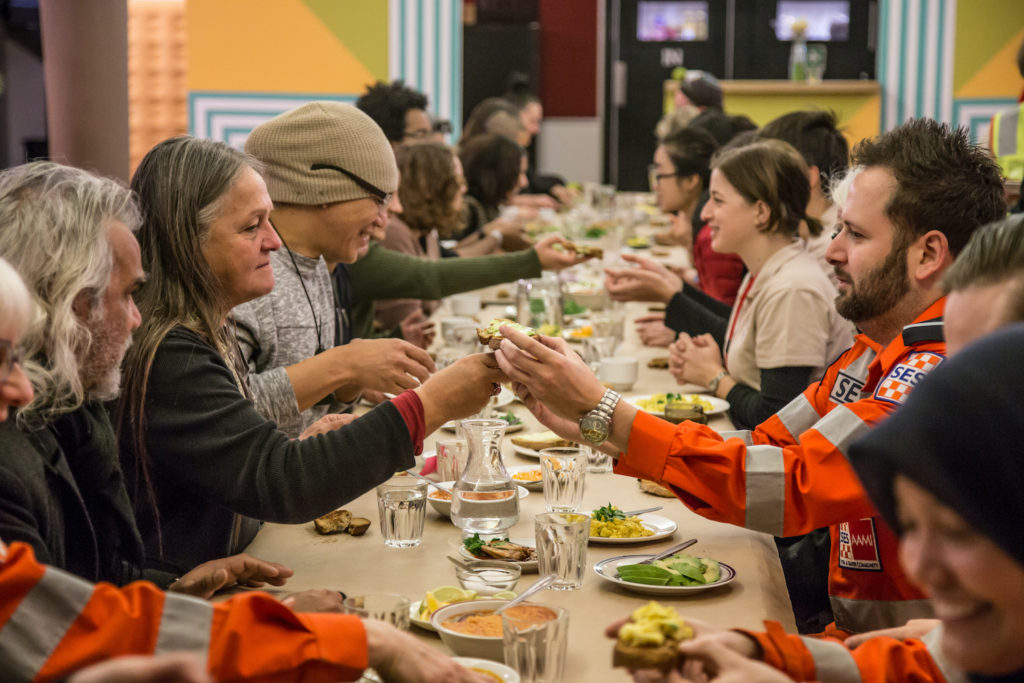
Image: Recovery Centre Community Breakfast by Dawn Weleski and Jen Rae, Refuge 2017: Flood
Photo by Bryony Jackson.
Image description: a long table of food with rows of people sitting either side talking and feeding one another breakfast.
The arts and community have a rich, long documented heritage whereas the arts and emergency services may not, at first glance, have much in common. Dig a little deeper and you discover a critical cross-over from which a shared language can emerge – the heightened space that operators in both landscapes inhabit when they are in ‘crisis’ or in ‘performance’. Artists and arts workers operate on adrenalin in the preparation, execution and aftermath of performance. It can be a gruelling, exhausting vocation often compared to the conditions of elite sport. Similarly, emergency services encounter circumstances that run from the banal to the risky and the very dangerous. Whether you’re working a show or inside an emergency, you’re inhabiting a space of not-knowing what is going to happen despite your preparation. Combine this shared aptitude with the very real sense of urgency all LAB participants expressed regarding climate change in 2016, and the potential for cross-sectoral success increases exponentially. Creative Producer, Tara Prowse, speaks of the mercurial dynamics of the first LAB,
…of an arts organization that’s focused on outcomes and presenting and 6pm shows and an emergency services manager who has to kind of find methods and ways to deal with chaos at the worst times of people’s lives and for artists, who had been making work about climate crisis, but not necessarily in climate crisis. And for elders like Vicki (Couzens) or other First Nations knowledge holders to be seen, and for their knowledge to be considered as an urgent part of: where we might all go?… there was something about focusing on the process and not knowing what would happen in that first year.
The success of Refuge depends upon the interactions in the LAB, and those interactions are highly dependent on the alchemy of participants. Year on year, the LAB evolved, deepening practice, introducing new people and forming collaborative partnerships. According to Catherine Jones, this maturing began early. From the 2016 to 2017 editions, there was ‘more of a level playing field’, less instruction of the artist by experts, more an equal exchange of ideas. Core artist Jen Rae noted at the time: this is what the challenge is, we now need to go deeper (MacDowall and Fraser 2018, 14).
The LAB’s progress is directly proportional to an absolute time commitment from all participants. Tara Prowse was surprised and delighted by the ongoing presence of the non-arts stakeholders throughout the 2016 LAB:
…when I’ve done labs over the years, when you have a group, some are coming and going, and others are there the whole time, the people who build that new knowledge are the group that is there the whole time, and the people who come and go, they might have key pieces of information, but they never have as much buy in. Everyone (at Refuge) stayed the whole time. Steve sat through things, you know, he was invited to come and do his presentation. But he came back and came back and came back. And, likewise with Christine.
Refuge exemplifies how refusing traditional programming structures and resisting institutional and individual expectations of one’s relationship to time at work can positively impact the creation of community and the practice of imagination.
For many Refuge participants, artists, community and service representatives, the LAB is both a mechanism to track the program’s history and the key to its future. For core artist Lorna Hannan, the Lab provoked personal and professional revelations. It was an intellectual and spiritual journey that I had been seeking all my life. In my mind, it becomes more and more like a fresco in a cathedral. At 87 years of age, Lorna is considered and wise. She conceives of the LAB as a ‘group mind’: people concentrating the intellectual and spiritual questioning on common problems and being really serious and dogged about it. It’s seeking more than answers to problems, it’s seeking meaning, and it has no cut-off point. Much like the rhizomatic space of Deleuze and Guattari’s model, it’s a continuum of imagining. Core artist Kate Sulan agrees with Lorna about the intellectual and spiritual uplift. For Kate, the fact that you’re actually sitting with people that you’d never usually sit with in an unlikely alliance that was instructive and expansive, having bigger conversations than the Groundhog Day discussions of sectoral survival that so debilitate artists and arts workers, was exhilarating. Steve Cameron puts it simply, the Lab created community.
It is a good problem to have: a methodology that immediately sticks fast with participants, accelerates imagineering, knowledge production and the forging of new relationships across sectors and disciplines. One might have expected this to have taken a couple of years, but it was well-formed early, partly because of the mix of participants and partly because of the urgency of the material. It is a classic example of good curation and timing. For the curatorial stewards, it begged the question: what do we do with this successful alchemy?
Arts House was committed to some kind of public outcome, to provide a shape that was deliverable to a public, and the Creative Producers’ task was to realise that. For Tara Prowse, producing is a balance of the productive tension between poetics and structure. She was deep in the poetics of the LAB but understood the need for structure to mediate public engagement:
how do we open up this process to more people and to the public, because the value of the LAB is so critical to the knowledge production, and then the kind of direction that everybody was going in. But it felt like a small group of people to be benefiting from that work. So, how does the process become public?
It’s an excellent question to ask. Part of the answer lies in the relationship between place and time. When Tara first approached Christine Drummond about Refuge, she discovered that North Melbourne Town Hall was a designated Emergency Relief Centre of the City of Melbourne. This provided the Arts House team a place with a strong conceptual reason for being there. But what kind of experience would most closely simulate the conditions of an emergency relief centre in a flood (2016) or a heatwave (2017)? The answer lay in how to structure time. A decision was taken to conduct a ‘performance’ over a 24 hour-period. What kinds of actions would occur in this timespan? Food needed to be provided and a place to stay and sleep, activities to keep people busy. Dramaturgically, it was an inspired decision although fraught with risk. In this way, it mirrored the conditions many participants felt stepping into the LAB for the first time except in these circumstances the participants were not only ‘stakeholders’ but also a wider public that was gathering around the program.
To be invited for a sleepover is an acknowledgement of friendship, to accept is an expression of trust: for young people, a sleepover is a rite of passage. Physical proximity and social intimacy are a corollary of an event that is simultaneously imbued with trepidation and excitement. In Refuge, where the invitation is made to a company of strangers and, at best, new colleagues, these feelings are amplified. Artistic, social and cultural boundaries collapse; the shared experience of doing things together, of playing together, of dreaming together, of doing all these actions in a heightened state ‘over time’ creates community.
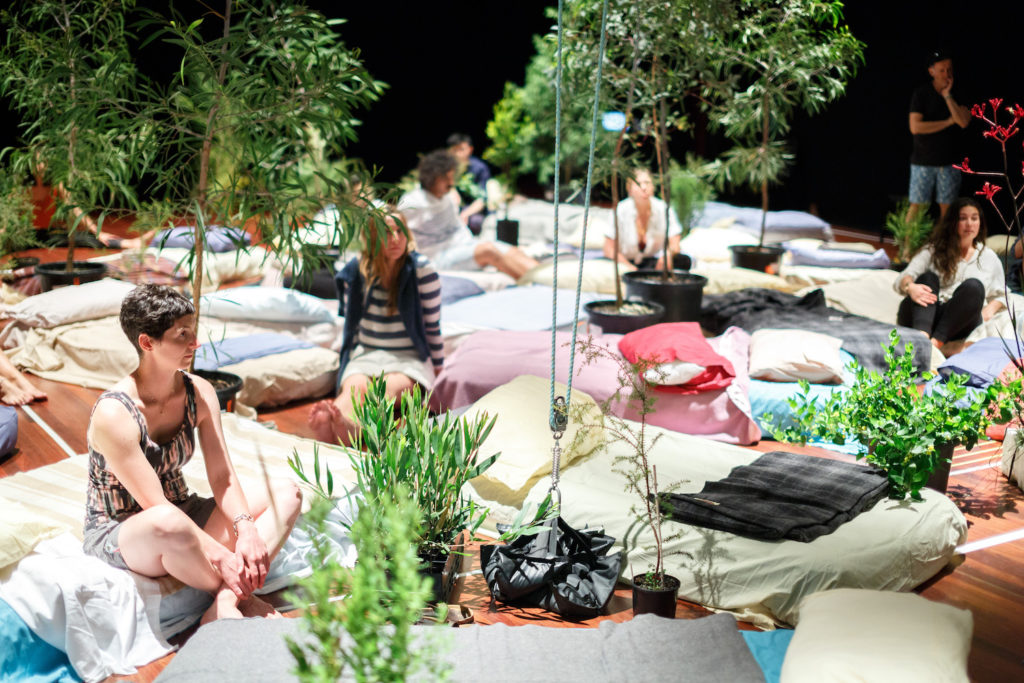
Image: Sleepover Refuge 2017: Heatwave
Photo by Bryony Jackson
Image description: Several people sit scattered in a room of blow up mattresses with pastel coloured sheets and checked grey blankets. In between the mattresses are different species of potted plants and trees.
The sleepover is emblematic of how the appreciation of time runs deep in the dramaturgy of Refuge: refusing traditional programming time-structures, resisting institutional and individual expectations on one’s relationship to time and work, embracing the possibility of sitting ‘in time’ with others. Through refusal, resistance and embrace, Refuge created a unique artistic and temporal space for participants, and importantly, one that enabled First Nations culture to move centre-stage.
The centring of First Nations knowledges, practices and people is a key curatorial platform of Refuge. Wiradjuri writer, Hannah Donnellly, was one of the lead artists of Refuge 2016 (Flood); Refuge 2017 (Heatwave) included The Elder’s Lounge presented in partnership with YIRRAMBOI and also featured significant artistic contributions from a number of artists including Dr Vicki Couzens, a Gunditjmara Keerray Woorroong woman and Emily Johnson of Yup’ik descent, Genevieve Grieves, a Worimi woman from Southeast Australia based in Melbourne and Mununjali author, Ellen Van Neerven; Tongan Punake, Latai Taumoepeau (ATP 2018), a lead artist in the 2019 Lab, was involved in the programs for 2020 (online) and 2021 (hybrid). From 2019, the producing team had a strong First Nations presence with Associate Producers Kalinda (Gal) Palmer, Nyikina/Jabbirr Jabbirr and Hannah Morphy-Walsh, Taungurung and then Kalyani Mumtaz, Trawlwoolway (2020-21).
A defining presence of Refuge is the involvement of Elders of the Kulin Nation including Wurundjeri Woi wurrung Elder Uncle Dave Wandin and Senior Wurundjeri Woi wurrung Elder Aunty Joy Murphy OA, Taungurung Elder Uncle Larry Walsh and Boon Wurrung Senior Elder N’arweet Dr Carolyn Briggs AM, whose reflections on Refuge form key interviews in this collection. All have provided a constant stewardship over the years and their influence on artists, programming, tone and sensibility has been profound.
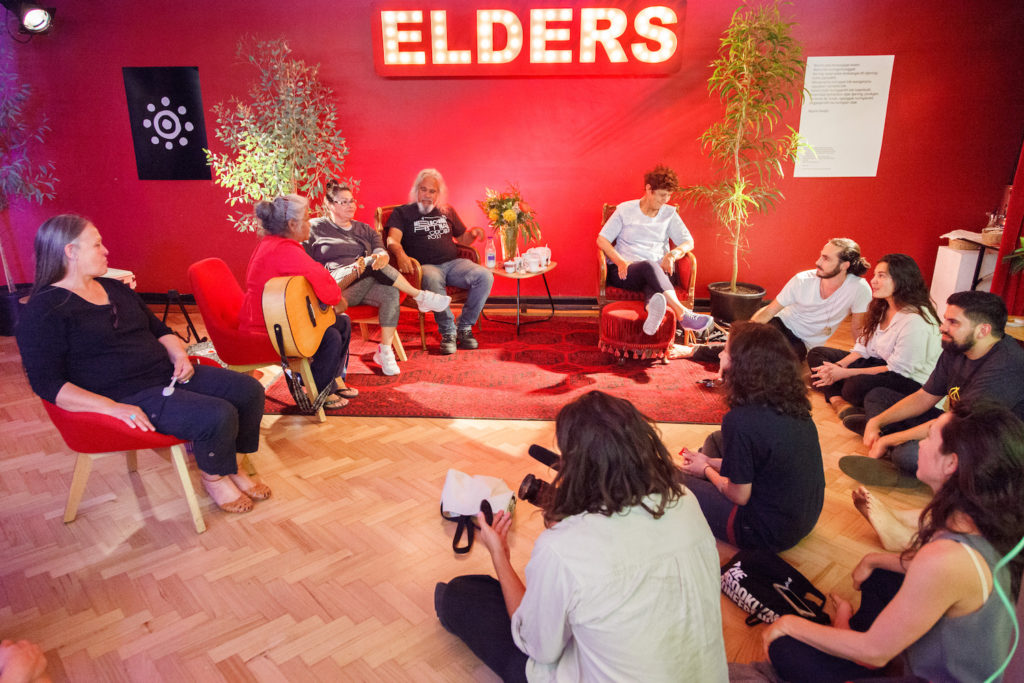
Image: THE ELDER’S LOUNGE, Presented by YIRRAMBOI Festival for Refuge 2017: Heatwave
Photo by Bryony Jackson.
Image description: Several people sit in an assortment of chairs talking amongst each other, drinking tea and listening to a woman play guitar. An Aboriginal man on the right wears a black t-shirt with white writing on it. They are in a room with a red wall and bright illuminated sign saying ‘ELDERS’ with two small eucalypt trees and a black and white artwork on the wall.
For core artist Jen Rae who is of Canadian Metis descent, The Elders Lounge presented at Refuge 2017 (Heatwave) was a significant marker in this eldership. The Lounge offered a sacred space for respite, conversation, information and nourishment for all Elders and Senior members from all walks of life and cultures (Arts House 2017, 13).
It was a gathering space. And there was a lot of care and community. There was no form, it was beautiful, things just sort of folded in, and there was a certain sense of value to having these conversations around disasters, and that, you know, our elders hold the key to the future. But nothing was being asked, you know, it was just to be.
To be. In time. And space. With others. Jen recalls Latai Taumoepeau’s leadership in the 2019 Lab
…bringing other First Nations voices to really talk about historical traumas, colonial traumas, but also, like, acknowledging the strength by uniting together and slowing processes down and not driving certain agendas.
Slowing down processes, readdressing time, its pace, its momentum, to a continuum. In the Refuge Talks Series (2020), Latai cites a Tongan proverb that provides a powerful dramaturgy for the whole Refuge program: pikipiki hama kae vaevae manava (putting the past in front and moving backwards through to the future). It is evident in Noongar writer Cass Lynch’s Watershed commissioned for Refuge 2021, where time in the place now called North Melbourne is mapped back 20,000 years. Watershed is an extension of Lynch’s research into colonial ideology and the intersection of Aboriginal cultural memory and the scientific concepts of Deep Time (artist’s website). It is many kinds of instruction in the way that it speaks to the cyclical nature of climate change and the knowledge drawn from the experience of the Boonwurrung peoples of the Kulin Nation and the pertinence of this knowledge to our current cycle. Written with permission from N’arweet Carolyn Briggs to share and discuss Boonwurrung cultural heritage and including Boonwurrung words and history from N’arweet’s The Journey Cycles of the Boonwurrung, Watershed is one of a number of N’arweet’s collaborations with artists in the final edition of Refuge.
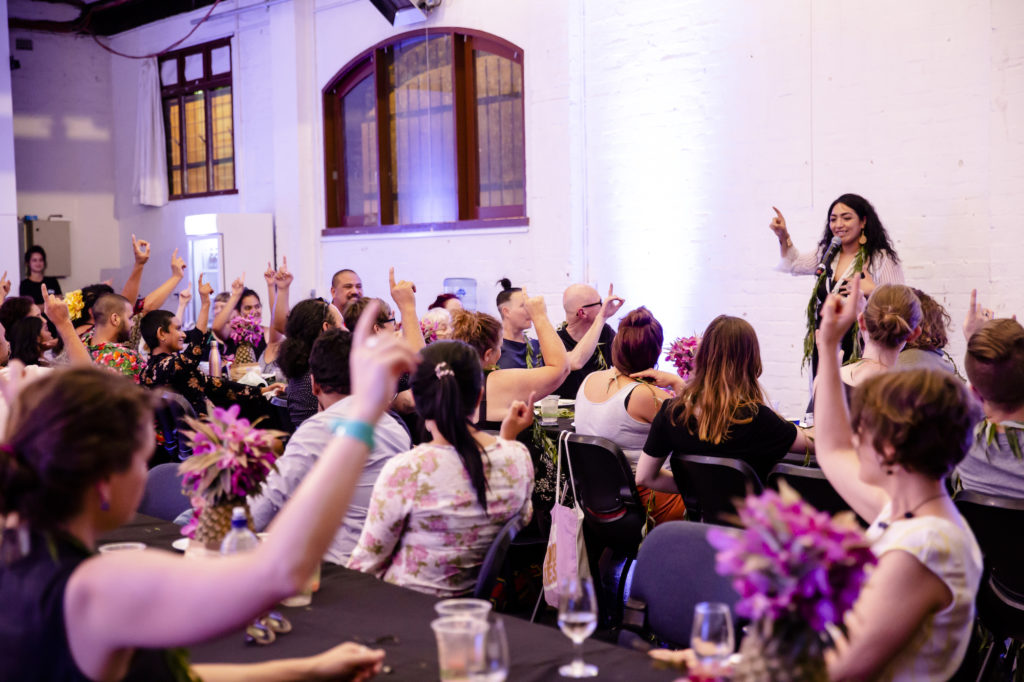
Image: Refuge INASI First Harvest, Refuge 2019: Displacement Lab, led by Latai Taumoepeau and Seini Taumoepeau
Photo by Bryony Jackson.
Image description: A large group of people sitting in rows along dinner tables watch a woman speak. They each hold one arm up and point to the roof.
Looking back on the six years of Refuge, there are many artworks and propositions that fall into the framing of Latai’s reference to the Tongan proverb and its corollary of holding multiple time-tenses simultaneously. Given the reality of our current lives and the likelihood of them being determined by the global pandemic for the foreseeable future, it is worth considering Uncle Larry Walsh’s offering, The Breath of the Mindye (Arts House website). A story of all Kulin people, it tells of the great Bundjil who, in the event of the people not following his lore, would send the snake Mindye to breathe out an illness that could kill or harm them.
Bundjil’s laws/lores were everything from how you treat your children, your visitors, old people to your land, to observing that fact that you were from different skin groupings and therefore there are certain animals you cannot eat or animals that you must hunt or eat in a certain way.
It speaks to the displacement of Culture from Nature and resonates deeply with the material and philosophical conditions which govern many of our lives. Specifically, it connects our treatment of land to the pandemic and teaches us that such ruptures are not novel and those who hold the knowledge of past events (tears in time) can also hold the knowledge of how we might understand it to chart a path to a sustainable future.
References
MacDowall, L., and Fraser, S. 2018. Refuge 2017 Evaluation Report, Research Unit of Public Cultures, The University of Melbourne.
Papastergiadis, N. 2017. The End of the Global South and the Cultures of the South. Thesis Eleven, Vol. 142, Issue 1.
https://www.qagoma.qld.gov.au/whats-on/exhibitions/past-exhibitions/the-9th-asia-pacific-triennial-of-contemporary-art-apt9/artists/latai-taumoepeau (accessed October 11, 2021)
https://semaphoreart.net/Cassie-Lynch (accessed October 11, 2021)
https://www.artshouse.com.au/the-breath-of-the-mindye/ (accessed October 11, 2021)
Header Image: MASS MOVEMENT FOLAU: The Departure by Latai Taumoepeau, Refuge 2021, Photo by Bryony Jackson.
Image description: A large group of people stand in a circle on the sand of Altona beach foreshore at sunrise. On the far right is a jetty, leading into clear, still ocean water. The sky is blue and grey with thick fluffy clouds.
About David Pledger
